Exhibit 99.4
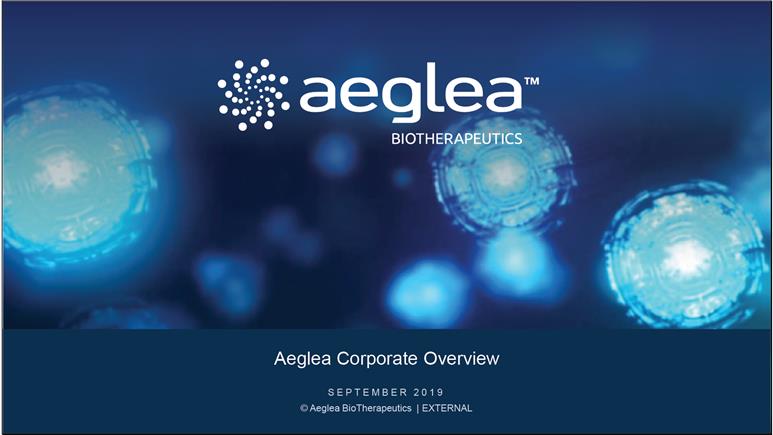
Aeglea tm Biotherapeutivs Aeglea Corporate Overview September 2019 @ Aeglea BioTherepeutics I External
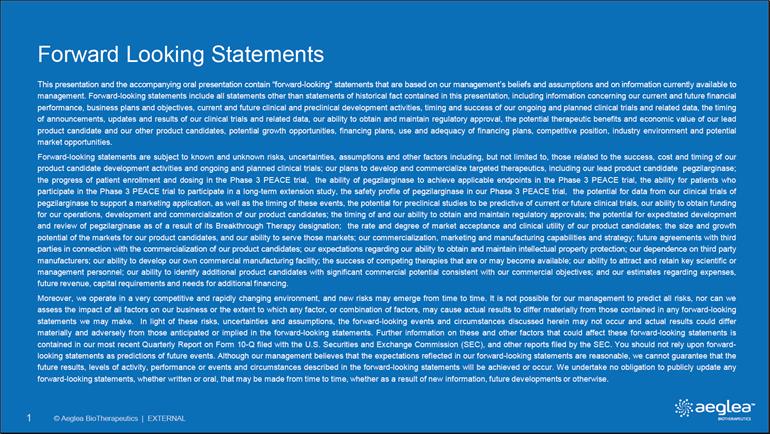
Forward Looking Statements This presentation and the accompanying oral presentation contain “forward-looking” statements that are based on our management’s beliefs and assumptions and on information currently available to management. Forward-looking statements include all statements other than statements of historical fact contained in this presentation, including information concerning our current and future financial performance, business plans and objectives, current and future clinical and preclinical development activities, timing and success of our ongoing and planned clinical trials and related data, the timing of announcements, updates and results of our clinical trials and related data, our ability to obtain and maintain regulatory approval, the potential therapeutic benefits and economic value of our lead product candidate and our other product candidates, potential growth opportunities, financing plans, use and adequacy of financing plans, competitive position, industry environment and potential market opportunities. Forward-looking statements are subject to known and unknown risks, uncertainties, assumptions and other factors including, but not limited to, those related to the success, cost and timing of our product candidate development activities and ongoing and planned clinical trials; our plans to develop and commercialize targeted therapeutics, including our lead product candidate pegzilarginase; the progress of patient enrollment and dosing in the Phase 3 PEACE trial, the ability of pegzilarginase to achieve applicable endpoints in the Phase 3 PEACE trial, the ability for patients who participate in the Phase 3 PEACE trial to participate in a long-term extension study, the safety profile of pegzilarginase in our Phase 3 PEACE trial, the potential for data from our clinical trials of pegzilarginase to support a marketing application, as well as the timing of these events, the potential for preclinical studies to be predictive of current or future clinical trials, our ability to obtain funding for our operations, development and commercialization of our product candidates; the timing of and our ability to obtain and maintain regulatory approvals; the potential for expeditated development and review of pegzilarginase as of a result of its Breakthrough Therapy designation; the rate and degree of market acceptance and clinical utility of our product candidates; the size and growth potential of the markets for our product candidates, and our ability to serve those markets; our commercialization, marketing and manufacturing capabilities and strategy; future agreements with third parties in connection with the commercialization of our product candidates; our expectations regarding our ability to obtain and maintain intellectual property protection; our dependence on third party manufacturers; our ability to develop our own commercial manufacturing facility; the success of competing therapies that are or may become available; our ability to attract and retain key scientific or management personnel; our ability to identify additional product candidates with significant commercial potential consistent with our commercial objectives; and our estimates regarding expenses, future revenue, capital requirements and needs for additional financing. Moreover, we operate in a very competitive and rapidly changing environment, and new risks may emerge from time to time. It is not possible for our management to predict all risks, nor can we assess the impact of all factors on our business or the extent to which any factor, or combination of factors, may cause actual results to differ materially from those contained in any forward-looking statements we may make. In light of these risks, uncertainties and assumptions, the forward-looking events and circumstances discussed herein may not occur and actual results could differ materially and adversely from those anticipated or implied in the forward-looking statements. Further information on these and other factors that could affect these forward-looking statements is contained in our most recent Quarterly Report on Form 11 @ Aeglea Biotherapeutics Aeglea Biotherapeutics 0-Q filed with the U.S. Securities and Exchange Commission (SEC), and other reports filed by the SEC. You should not rely upon forward-looking statements as predictions of future events. Although our management believes that the expectations reflected in our forward-looking statements are reasonable, we cannot guarantee that the future results, levels of activity, performance or events and circumstances described in the forward-looking statements will be achieved or occur. We undertake no obligation to publicly update any forward-looking statements, whether written or oral, that may be made from time to time, whether as a result of new information, future developments or otherwise. @ Aeglea Biotherapeutics Aeglia Biotherapeutics
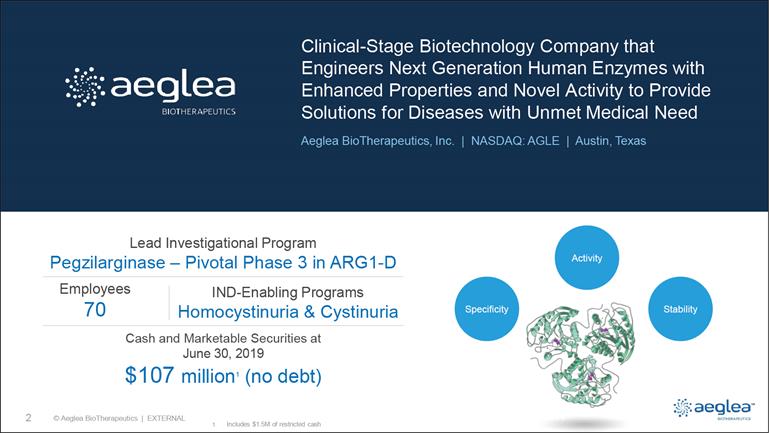
Aeglea Biotherapeutics Clinical-Stage Biotechnology Company that Engineers Next Generation Human Enzymes with Enhanced Properties and Novel Activity to Provide Solutions for Diseases with Unmet Medical Need Aeglea BioTherapeutics, Inc.|NASDAQ: AGLE|Austin, Texas Lead Investigational Program Pegzilarginase – Pivotal Phase 3 in ARG1-D Lead Investigational Program Pegzilarginase – Pivotal Phase 3 in ARG1-D Employees 70 IND-Enabling Programs Homocystinuria & Cystinuria Cash and Marketable Securities at June 30, 2019 $107 million1 (no debt) Specificity Activity Stability Includes $1.5M of restricted cash 2 @ Aeglea Biotherapeutics I External Aeglea Biotherapeutics
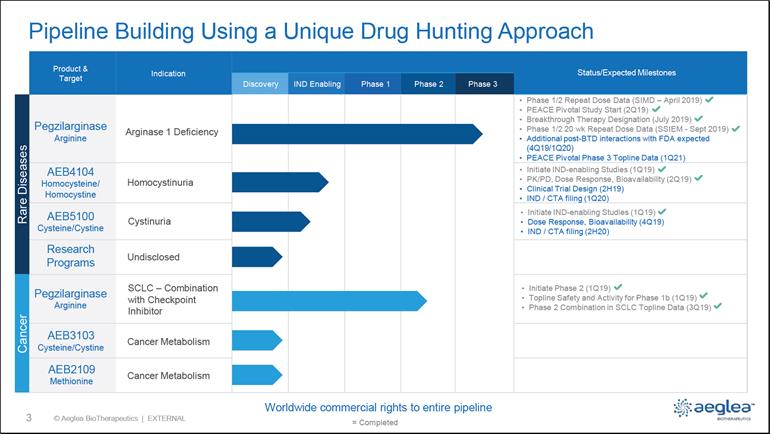
Pipeline Building Using a Unique Drug Hunting Approach Product &Target Indication Indication Discovery IND Enabling Phase 1 Phase 2 Phase 3 Pegzilarginase Arginine Arginase 1 Deficiency AEB4104 Homocysteine/ Homocystine Homocystinuria AEB5100 Cysteine/Cystine Cystinuria Research Programs Undisclosed Pegzilarginase Arginine SCLC – Combination with Checkpoint Inhibitor AEB3103 Cysteine/Cystine Cancer Metabolism AEB2109 Methionine Cancer Metabolism Worldwide commercial rights to entire pipeline Status/Expected Milestones Phase 1/2 Repeat Dose Data (SIMD – April 2019) PEACE Pivotal Study Start (2Q19) Breakthrough Therapy Designation (July 2019) Phase 1/2 20 wk Repeat Dose Data (SSIEM - Sept 2019) Additional post-BTD interactions with FDA expected (4Q19/1Q20) PEACE Pivotal Phase 3 Topline Data (1Q21) Phase 1/2 Repeat Dose Data (SIMD – April 2019) PEACE Pivotal Study Start (2Q19) Breakthrough Therapy Designation (July 2019) Phase 1/2 20 wk Repeat Dose Data (SSIEM - Sept 2019) Additional post-BTD interactions with FDA expected (4Q19/1Q20) PEACE Pivotal Phase 3 Topline Data (1Q21) Initiate IND-enabling Studies (1Q19) Dose Response, Bioavailability (4Q19) IND / CTA filing (2H20) Initiate Phase 2 (1Q19) Topline Safety and Activity for Phase 1b (1Q19) Phase 2 Combination in SCLC Topline Data (3Q19) Cancer Rare Diseases 3 @ Aeglea Biotherapeutics I External Completed Aeglea Biotherapeutics

Strong Momentum with Multiple Near-term Catalysts Recent Milestones Pegzilarginase: ARG1-D Breakthrough Therapy Designation granted by the FDA First patient dosed in the pivotal Phase 3 PEACE trial Statistically significant reductions in plasma arginine (p<0.001) with accompanying clinical improvements (11/14 or 79% at 20 weeks) with pegzilarginase in Phase 1/2 reaffirm pivotal Phase 3 trial design for ARG1-D All patients (n=14) who completed the Phase 1/2 are now being dosed in the open label extension study; 10 patients subcutaneously PRV eligible: rare pediatric disease designation granted by FDA Raised $69 million in February 2019 public follow-on AEB4104: Homocystinuria in IND-enabling studies Reduces plasma homocysteine levels, improves disease related abnormalities with 100% survival in preclinical model at 18 weeks Candidate characteristics support subcutaneous administration Anticipated human dose of ~1.0 mg/kg with ~80% bioavailability AEB5100: Cystinuria in IND-enabling studies Reduces plasma and urine cystine levels and reduces kidney stone formation in a preclinical model Anticipated Milestones Pegzilarginase: ARG1-D Additional post-BTD interaction with FDA expected 4Q19/1Q20 Topline pivotal Phase 3 data: 1Q2021AEB4104: Homocystinuria Clinical Trial Design and Regulatory Feedback: 2H2019 IND / CTA filing: 1Q2020 AEB5100: Cystinuria Dose response and bioavailability data: 4Q2019 IND / CTA filing: 2H2020 4 @ Aeglea Biotherapeutics I External Aeglea Biotherapeutics
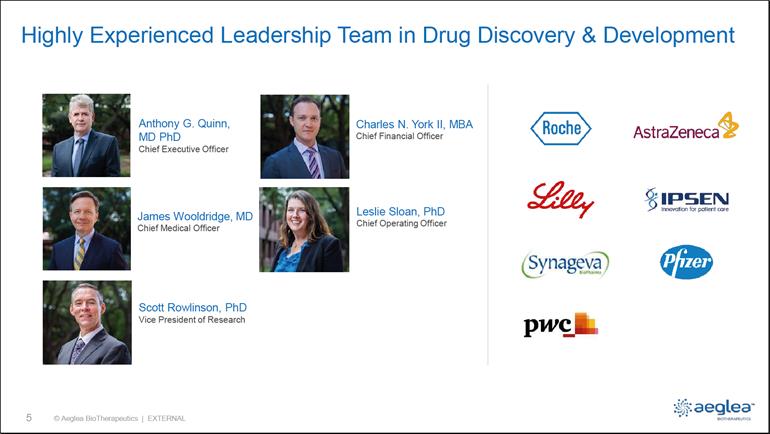
Highly Experienced Leadership Team in Drug Discovery & Development Anthony G. Quinn, MD PhD Chief Executive Officer Roche AstraZeneca, Lilly, Ipsen, Synageva, Pfizer, PWC James Wooldridge, MD Chief Medical Officer Scott Rowlinson, PhD Vice President of Research Charles N. York II, MBA Chief Financial Officer Leslie Sloan, PhD Chief Operating Officer 5 @ Aeglea BioTherapeutics I External Aeglea Biotherapeutics
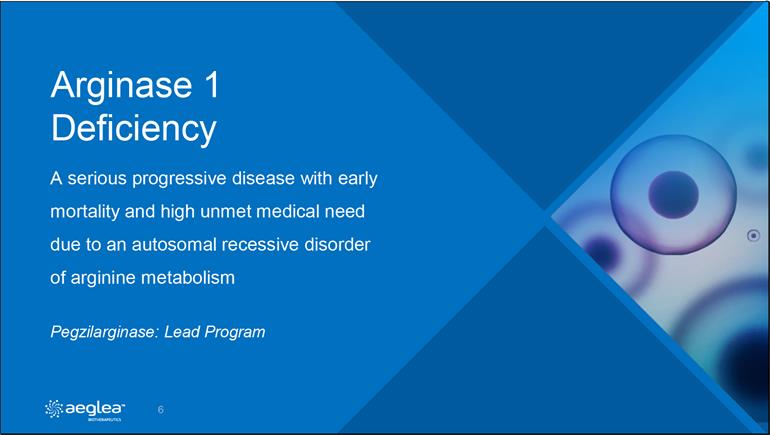
Arginase 1 Deficiency A serious progressive disease with early mortality and high unmet medical need due to an autosomal recessive disorder of arginine metabolism Pegzilarginase: Lead Program Aeglea Biotherapeutics 6
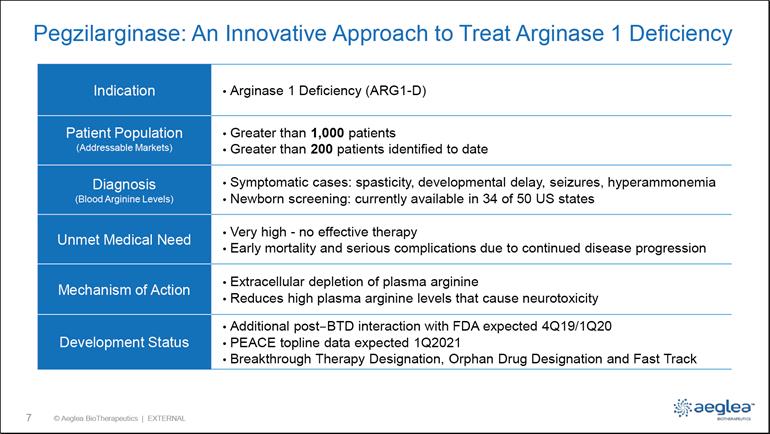
Pegzilarginase: An Innovative Approach to Treat Arginase 1 Deficiency Indication Patient Population (Addressable Markets) Diagnosis (Blood Arginine Levels Unmet Medical Need Mechanism of Action Development Status Arginase 1 Deficiency (ARG1-D) Greater than 1,000 patients Greater than 200 patients identified to date Symptomatic cases: spasticity, developmental delay, seizures, hyperammonemia Newborn screening: currently available in 34 of 50 US states Very high - no effective therapy Early mortality and serious complications due to continued disease progression Extracellular depletion of plasma arginine Reduces high plasma arginine levels that cause neurotoxicity Additional post–BTD interaction with FDA expected 4Q19/1Q20 PEACE topline data expected 1Q2021 Breakthrough Therapy Designation, Orphan Drug Designation and Fast Track 7 @ Aeglea BioTherapeutics I External aeglea Biotherapeutics
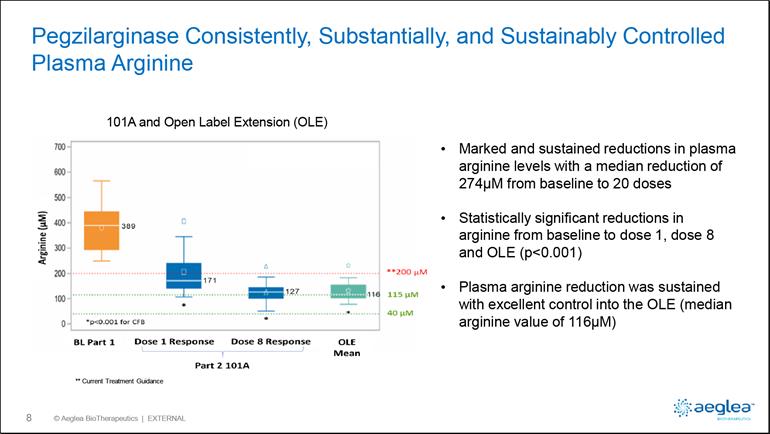
Pegzilarginase Consistently, Substantially, and Sustainably Controlled Plasma Arginine 101A and Open Label Extension (OLE) Arginine (UM) 700 600 500 400 300 200 100 0 389 171 127 116Pc0.1001 for CFB BL Part 1 Dose 1 Response Dose 8 Response Ole Mean **200µm 115 µm 40 µmPart 2 101A Marked and sustained reductions in plasma arginine levels with a median reduction of 274µM from baseline to 20 doses Statistically significant reductions in arginine from baseline to dose 1, dose 8 and OLE (p˂0.001) Plasma arginine reduction was sustained with excellent control into the OLE (median arginine value of 116µM) ** Current Treatment Guidance 8 @ Aeglea BioTherepeutics I External aeglea Biotherapeutics
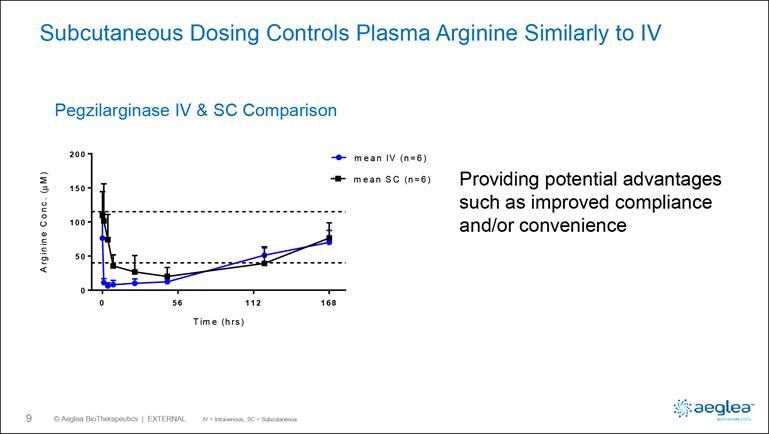
Subcutaneous Dosing Controls Plasma Arginine Similarly to IV Pegzilarginase IV & SC Comparison Arginine Conc (UM) 200 150 100 50 0 0 56 112 168 Time (hrs) Mean IV (n=6) mean SC (n=6) Providing potential advantages such as improved compliance and/or convenience 9 @ Aeglea BioTherapeutics I External IV = Intravenous, SC = Subcutaneous aeglea Biotherapeutics
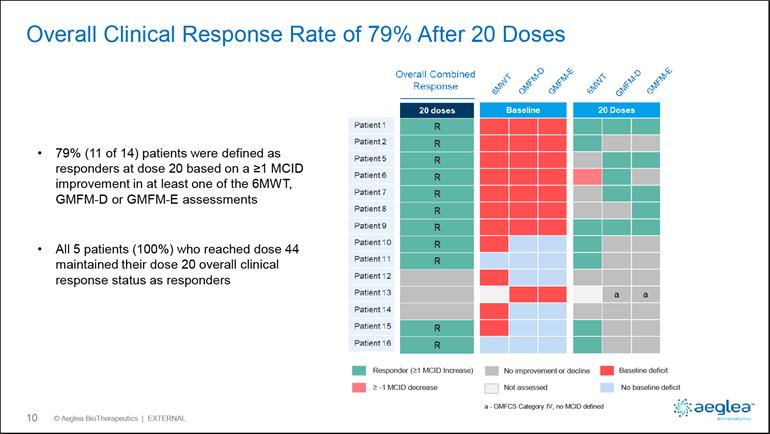
Overall Clinical Response Rate of 79% After 20 Doses 79% (11 of 14) patients were defined as responders at dose 20 based on a ≥1 MCID improvement in at least one of the 6MWT, GMFM-D or GMFM-E assessments All 5 patients (100%) who reached dose 44 maintained their dose 20 overall clinical response status as respondersOverall Combined Response BMWT GMFM-D GMFM-E GMWT GMFM-D GMFM-E Patient 20 Doses Baseline 20 Doses R R R R R R RR R R R R R R R R 1 Patient 2 Patient 3 Patient 4 Patient 5 Patient 6 Patient 7 Patient 8 Patient 9 Patient 10 Patient 11 Patient 12 Patient 13 Patient 14 Patient 15 Patient 16 Responder (≥1 MCID Increase) No improvement or decline Baseline deficit Baseline deficit Not assessedNo baseline deficit a - GMFCS Category IV, no MCID defined 10 @ Aeglea BioTherapeutics I External aeglea Biotherapeutics
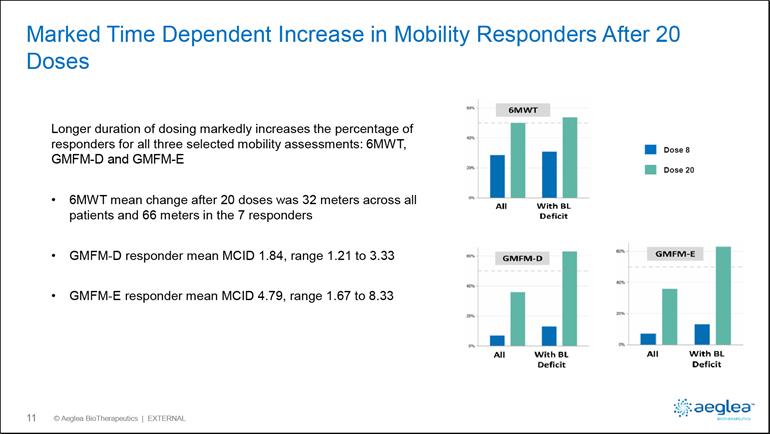
Marked Time Dependent Increase in Mobility Responders After 20 Doses Longer duration of dosing markedly increases the percentage of responders for all three selected mobility assessments: 6MWT, GMFM-D and GMFM-E 6MWT mean change after 20 doses was 32 meters across all patients and 66 meters in the 7 responders GMFM-D responder mean MCID 1.84, range 1.21 to 3.33 GMFM-E responder mean MCID 4.79, range 1.67 to 8.33 6MWT All With BL Deficit Dose 8 Dose 20 GMFM-D All With BL Deficit GMFM-E Deficit 11 @ Aeglea Biotherapeutics I External Aeglea Biotherapeutics
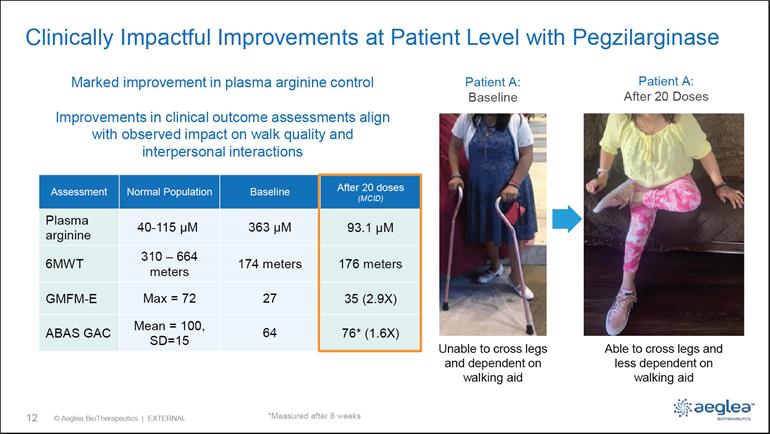
Clinically Impactful Improvements at Patient Level with Pegzilarginase Marked improvement in plasma arginine control Improvements in clinical outcome assessments align with observed impact on walk quality and interpersonal interactions Assessment Plasma arginine 6MWT GMFM-E ABAS GAC Normal Population 40-115 µM 310 – 664 meters Max = 72 Mean = 100, SD=15 Baseline 363 µM 174 meters 27 64 After 20 doses (MCID) 93.1 µM 176 meters 35 (2.9X) 76* (1.6X) Patient A: Baseline Unable to cross legs and dependent on walking aid Patient A: After 20 Doses Able to cross legs and less dependent on walking aid *Measured after 8 weeks 12 @ Aeglea BioTherapeutics I External Aeglea Biotherapeutics
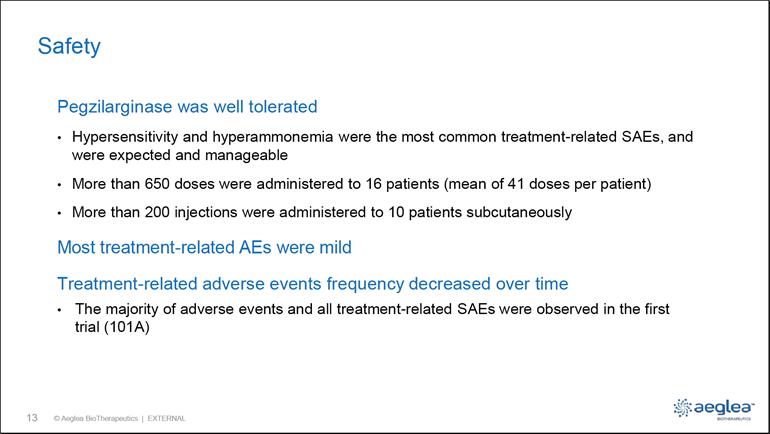
Safety Pegzilarginase was well tolerated Hypersensitivity and hyperammonemia were the most common treatment-related SAEs, and were expected and manageable More than 650 doses were administered to 16 patients (mean of 41 doses per patient) More than 200 injections were administered to 10 patients subcutaneously Most treatment-related AEs were mild Treatment-related adverse events frequency decreased over time The majority of adverse events and all treatment-related SAEs were observed in the first trial (101A) 13 @ Aeglea BioTherapeutics I External Aeglea Biotherapeutics
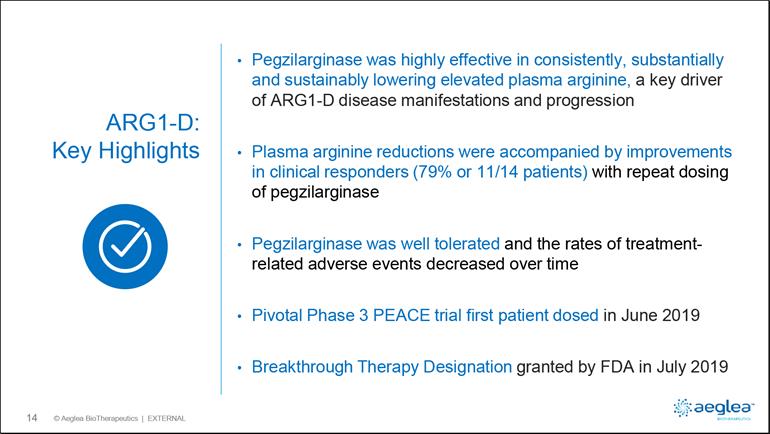
ARG1-D: Key Highlights Pegzilarginase was highly effective in consistently, substantially and sustainably lowering elevated plasma arginine, a key driver of ARG1-D disease manifestations and progression Plasma arginine reductions were accompanied by improvements in clinical responders (79% or 11/14 patients) with repeat dosing of pegzilarginase Pegzilarginase was well tolerated and the rates of treatment-related adverse events decreased over time Pivotal Phase 3 PEACE trial first patient dosed in June 2019 Breakthrough Therapy Designation granted by FDA in July 2019 14 @ Aeglea BioTherapeutics I External Aeglea Biotherapeutics
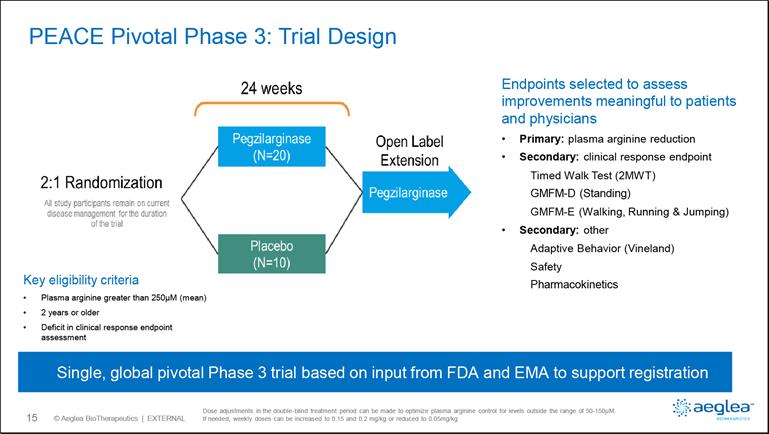
PEACE Pivotal Phase 3: Trial Design 24 weeks Pegzilarginase (N=20) 2:1 Randomization All study participants remain on current disease management for the duration of the trial Placebo (N=10) Open Lable extension Pegzilarginase Key eligibility criteria Plasma arginine greater than 250µM (mean) 2 years or older Deficit in clinical response endpoint assessment Endpoints selected to assess improvements meaningful to patients and physicians Primary: plasma arginine reduction Secondary: clinical response endpoint Timed Walk Test (2MWT) GMFM-D (Standing) GMFM-E (Walking, Running & Jumping) Secondary: other Adaptive Behavior (Vineland) Safety Pharmacokinetics Single, global pivotal Phase 3 trial based on input from FDA and EMA to support registration Dose adjustments in the double-blind treatment period can be made to optimize plasma arginine control for levels outside the range of 50-150µM. If needed, weekly doses can be increased to 0.15 and 0.2 mg/kg or reduced to 0.05mg/kg 15 @ Aeglea BioTherapeutics I External Aeglea Biotherapeutics
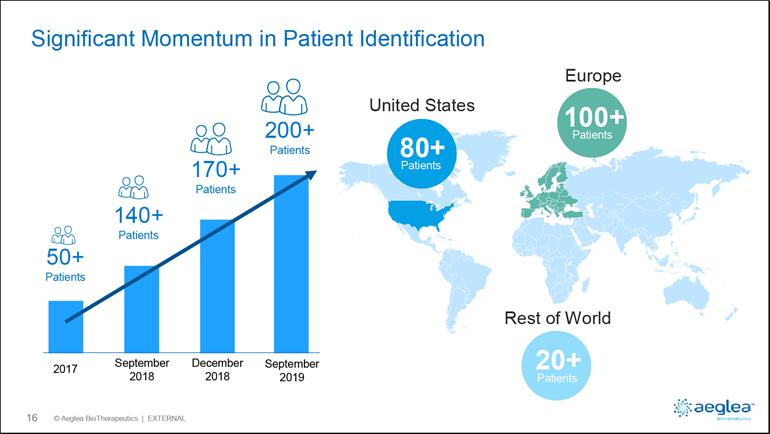
Significant Momentum in Patient Identification 200+ patients 170+ Patients 140+ Patients 50+ Patients 2017 September 2018 December 2018 September 2019 United States 80+ Patients Europe 100+ Patients Rest of World 20+ Patients 16 @ Aeglea Biotherapeutics I External Aeglea Biotherapeutics
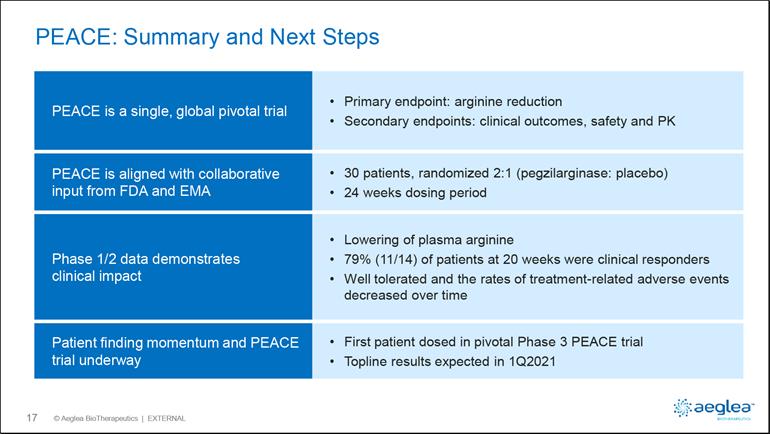
PEACE: Summary and Next Steps PEACE is a single, global pivotal trial PEACE is aligned with collaborative input from FDA and EMA Phase 1/2 data demonstrates clinical impact Patient finding momentum and PEACE trial underway Primary endpoint: arginine reduction Secondary endpoints: clinical outcomes, safety and PK 30 patients, randomized 2:1 (pegzilarginase: placebo) 24 weeks dosing period Lowering of plasma arginine 79% (11/14) of patients at 20 weeks were clinical responders Well tolerated and the rates of treatment-related adverse events decreased over time First patient dosed in pivotal Phase 3 PEACE trial Topline results expected in 1Q2021 17 @ Aeglea BioTherapeutics I External Aeglea Biotherapeutics
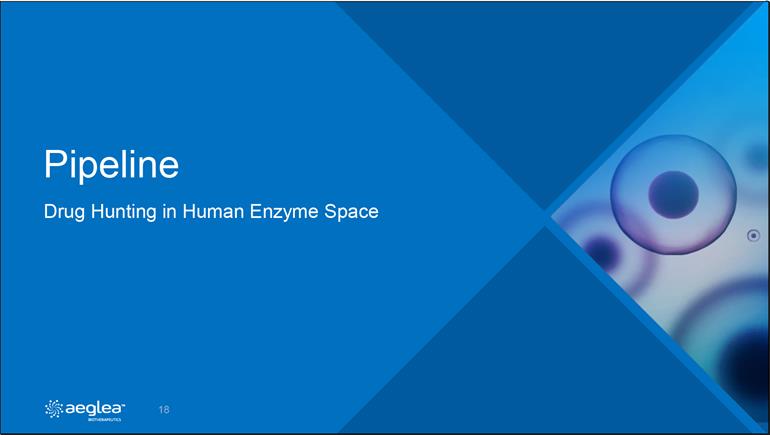
Pipeline Drug Hunting in Human Enzyme Space Aeglea Biotherapeutics 18
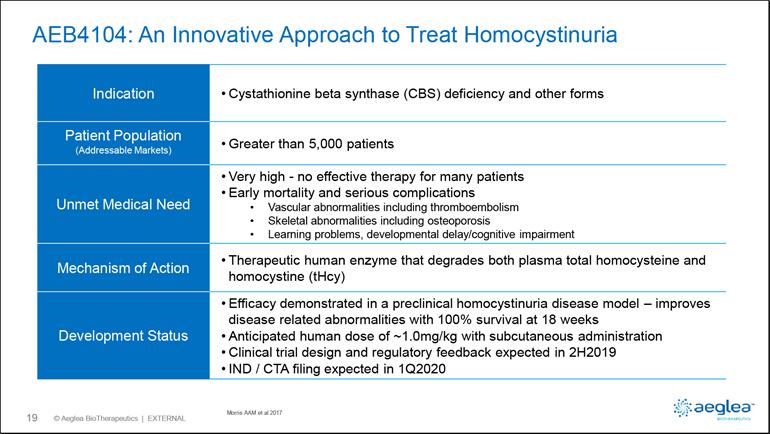
AEB4104: An Innovative Approach to Treat Homocystinuria Indication Patient Population Addressable Markets Unmet Medical Need Mechanism Of Action Development Status Cystathionine beta synthase (CBS) deficiency and other forms Greater than 5,000 patients Very high - no effective therapy for many patients Early mortality and serious complications Vascular abnormalities including thromboembolism Skeletal abnormalities including osteoporosis Learning problems, developmental delay/cognitive impairment Therapeutic human enzyme that degrades both plasma total homocysteine and homocystine (tHcy) Efficacy demonstrated in a preclinical homocystinuria disease model – improves disease related abnormalities with 100% survival at 18 weeks Anticipated human dose of ~1.0mg/kg with subcutaneous administration Clinical trial design and regulatory feedback expected in 2H2019IND / CTA filing expected in 1Q2020 Morris AAM et al 2017 19 @ Aeglea BioTherapeutics I External Aeglea Biotherapeutics
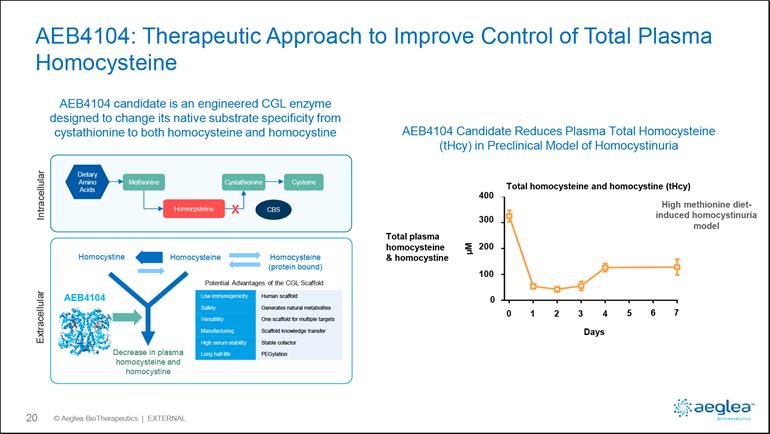
AEB4104: Therapeutic Approach to Improve Control of Total Plasma Homocysteine AEB4104 candidate is an engineered CGL enzyme designed to change its native substrate specificity from cystathionine to both homocysteine and homocysteine Dietary amino Acids Methionine Hornocysteine Cystathionine Cysteine CBS Extracellular Intracellular Homocystine Homocysteine Homocysteine (Protein Bound) Potential Advantages of the CGL Scaffold AEB4104 Decrease in plasma homocysteine and homocystine Low immunogenicity Safety Versatility Manufacturing High Serum Stability Long Half Life Human Scaffold Generates Natural Metabolites One Scaffold for Multiple targets scaffold knowledge transfer Stable oofactor PEGylation AEB4104 Candidate Reduces Plasma Total Homocysteine (tHcy) in Preclinical Model of Homocystinuria Total homocysteine and homocystine (tHcy) Total plasma homocysteine & homocystine High methionine diet-induced homocystinuria model Days 20 @ Aeglea BioTherapeuticsI External Aeglea Biotherapeutics
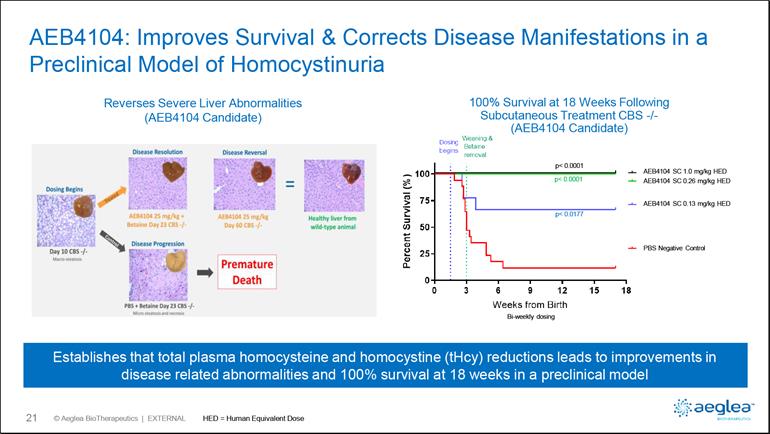
AEB4104: Improves Survival & Corrects Disease Manifestations in a Preclinical Model of Homocystinuria Reverses Severe Liver Abnormalities (AEB4104 Candidate) Disease Resolution Dosing Begins Day 10 CBS /- AEB4104 25 mg/kg+ Betaine day 23 CBS-/- Disease reversal AEB4104 25mg /kg Day 60 CBS-/- Healthy Liver from wild type animal disease Progression PBS + Betaine day 23 CBS-/- micro steatiosis and necrosis Premature Death 100% Survival at 18 Weeks Following Subcutaneous Treatment CBS -/- (AEB4104 Candidate) Weaning Betaine Removal Dosing begins Percent Survival (%) Week from Birth BI-weekly Dosing AEB4104 SC 1.0 mg/kg HED AEB4104 SC 0.25 mg/kg HED AEB4104 SC 0.13 mg/kg HED PBS Negative Control Establishes that total plasma homocysteine and homocystine (tHcy) reductions leads to improvements in disease related abnormalities and 100% survival at 18 weeks in a preclinical model HED = Human Equivalent Dose 21 @ Aeglea BioTherapeutics I External Aeglea Biotherapeutics
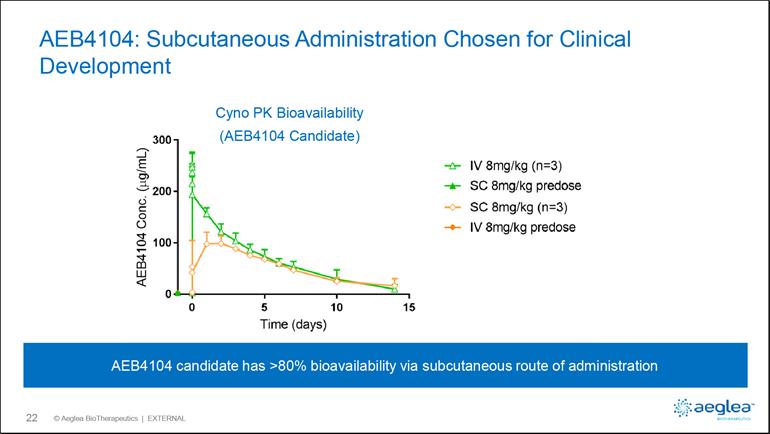
AEB4104: Subcutaneous Administration Chosen for Clinical Development Cyno PK Bioavailability (AEB4104 Candidate) AEB4104 Conc (Ug/ml)Time (day) IV 8mg/kg (n=3) SC 8mg/Kg Predose sc 8mg/kg (n=3) IV 8 mg/kg predose AEB4104 candidate has >80% bioavailability via subcutaneous route of administration 22 @ aeglea Biotherapeutics I External Aeglea Biotherapeutics
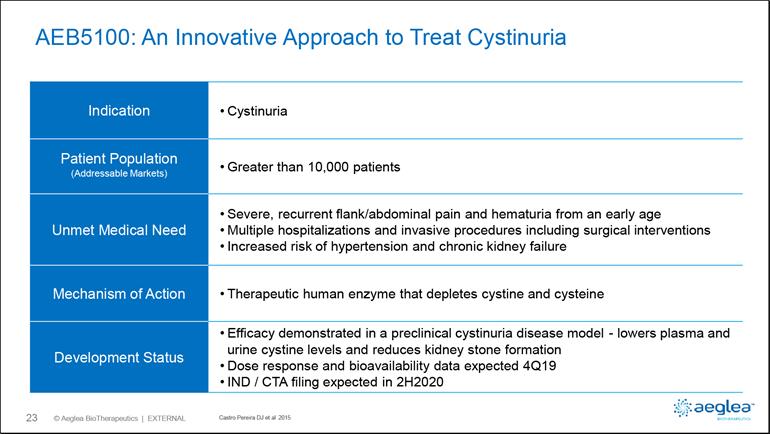
AEB5100: An Innovative Approach to Treat Cystinuria Indication Patient Population (Addressable Markets ) Unmet Medical need Mechanism of Action Development Status Systinuria Greater Than 10,000 Patients Severe, recurrent flank/abdominal pain and hematuria from an early age Multiple hospitalizations and invasive procedures including surgical interventions Increased risk of hypertension and chronic kidney failure Therapeutic human enzyme that depletes cystine and cysteine Efficacy demonstrated in a preclinical cystinuria disease model - lowers plasma and urine cystine levels and reduces kidney stone formation Dose response and bioavailability data expected 4Q19IND / CTA filing expected in 2H2020 Castro Pereira DJ et al 2015 23 @ Aeglea BioTherapeutics I External Aeglea Biotherapeutics
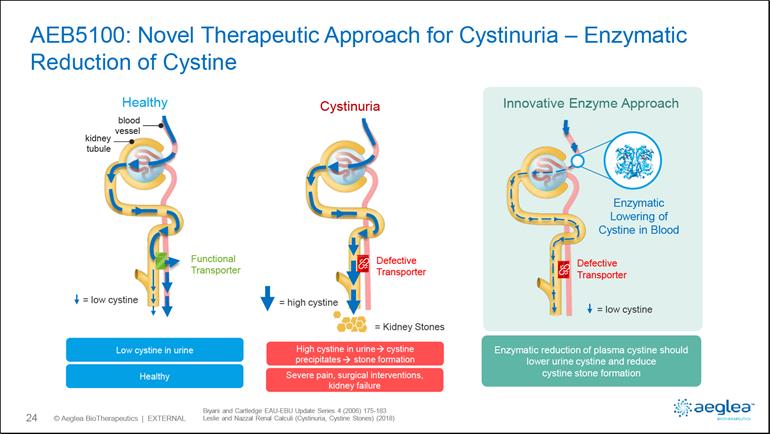
AEB5100: Novel Therapeutic Approach for Cystinuria – Enzymatic Reduction of Cystine Healthy Blood vessel kidney tubule low cystine functional transporter low cystine in urine healthy Cystinuria defective transporter high cystine = kidney stones high cystine in urine cystine precipitates stone formation severe pain, surgical interventions, kidney failure innovative enzyme approach enzymatic lowring cystine in blood defective transporter low cystine enzymatic reduction of plasma cystine should lower urine cystine and reduce cystine stone formation Biyani and Cartledge EAU-EBU Update Series 4 (2006) 175-183 Leslie and Nazzal Renal Calculi (Cystinuria, Cystine Stones) (2018) 24 @ Aeglea BioTherapeutics Aeglea Biotherapeutics
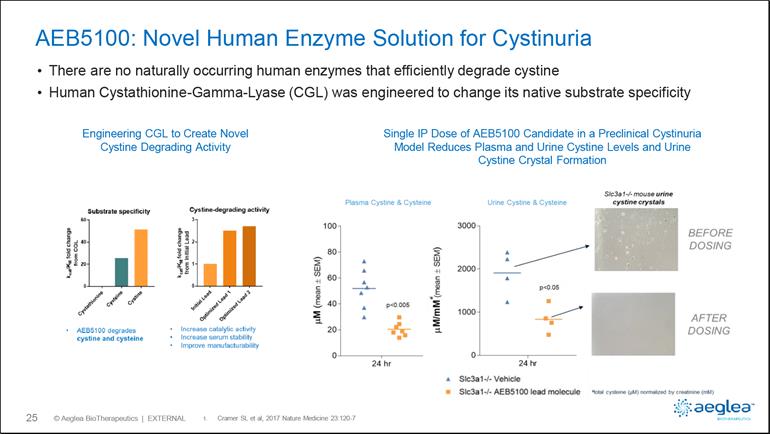
AEB5100: Novel Human Enzyme Solution for Cystinuria There are no naturally occurring human enzymes that efficiently degrade cystine Human Cystathionine-Gamma-Lyase (CGL) was engineered to change its native substrate specificity Engineering CGL to Create Novel Cystine Degrading Activity Single IP Dose of AEB5100 Candidate in a Preclinical Cystinuria Model Reduces Plasma and Urine Cystine Levels and Urine Cystine Crystal Formation Substrate specificity cystine – degrading activity kcat/km fold change from CGL Cystathionine Cysteine Cystine kcat/km fold change from initial lead AEB5100 degrades cystine and cysteine cystine – degrading activity initial lead optimized lead 1 optimized lead Increase catalytic activity increase serum stability improve manufacturability Plasma cystine & Cysteine urine Cystine & Cysteine Before Dosing After Dosing Um ( mean +-Sem ) 24 Hrs um/mM(mean +- SEM) Sec3a1-/-mouse urine cystine crystals sic3a1-/-vehicle SIC3a1-/- AEB lead molecule *total cysteine (um) normalized by creatinine (mM) Cramer SL et al, 2017 Nature Medicine 23:120-7 25 @ aeglea Biotherapeutics I External Aeglea Biotherapeutics
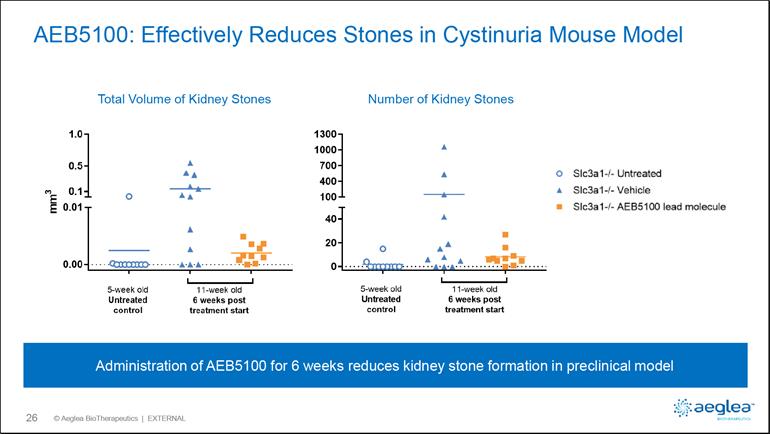
AEB5100: Effectively Reduces Stones in Cystinuria Mouse Model Total Volume of Kidney Stones Number of Kidney Stones mm3 5 Week old untreated control 11 week old 6 weeks post treatment start 1.0 0.5 0.1 0.01 0.00 5 week old untreated control 11 week old 6 weeks post treatment start sic3a1-/- untreated Sic3a1-/-vehicle Sic3a1-/- AEB5100 lead molecule Administration of AEB5100 for 6 weeks reduces kidney stone formation in preclinical model 26 @ Aeglea BioTherapeutics I External Aeglea Biotherapeutics
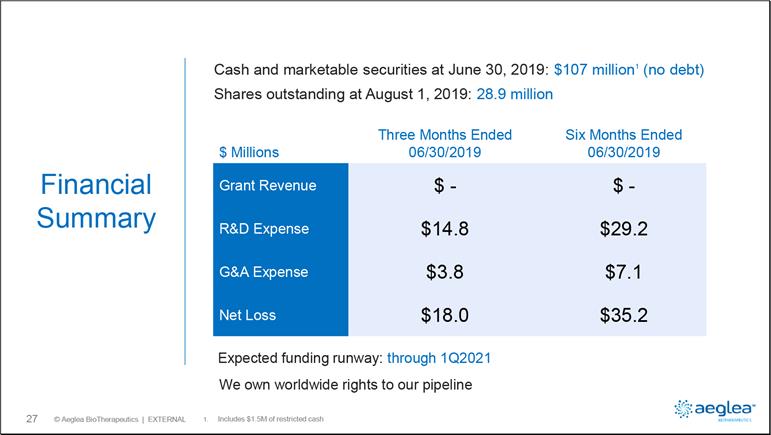
Cash and marketable securities at June 30, 2019: $107 million1 (no debt) Shares outstanding at August 1, 2019: 28.9 million Financial Summary $ millions Three Months Ended 06/30/2019 Six months Ended 06/30/2019 Grant Revenue R&D Expense G&A Expense Net Loss $- &14.8 $3.8 $18.0 $- $29.2 $7.1 $35.2 Expected funding runway: through 1Q2021 We own worldwide rights to our pipeline 1. Includes $1.5M of restricted cash 27 @ Aeglea Biotherapeutics I External Aeglea Biotherapeutics
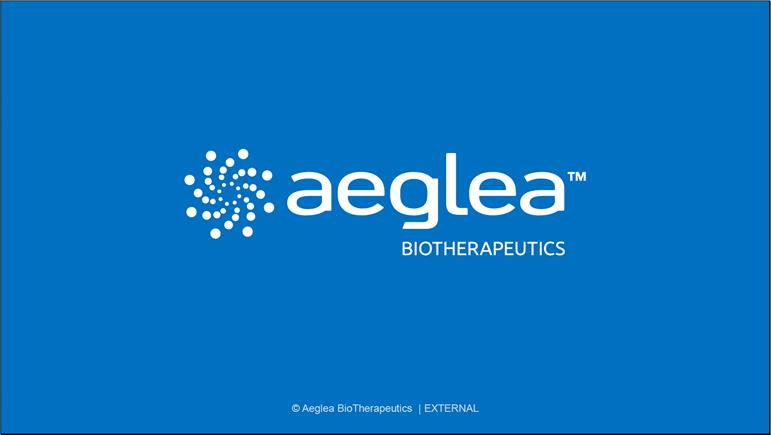
Aeglea tm BioTherapeutics @ aeglea Biotherapeutics I External
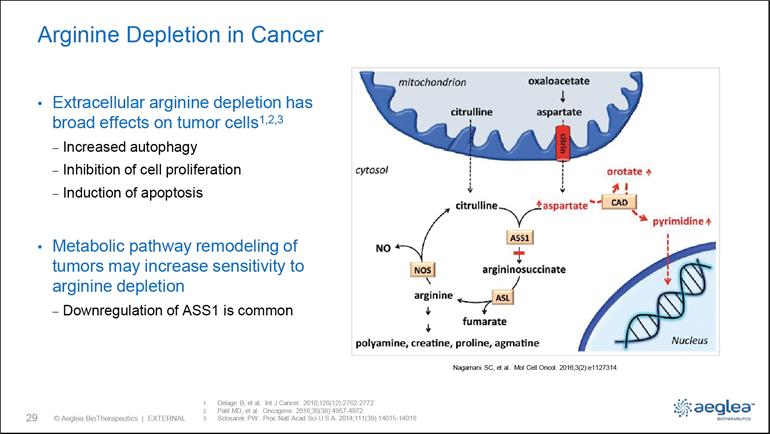
Arginine Depletion in Cancer Extracellular arginine depletion has broad effects on tumor cells1,2,3 Increased autophagy Inhibition of cell proliferation Induction of apoptosis Metabolic pathway remodeling of tumors may increase sensitivity to arginine depletion Downregulation of ASS1 is common Mitochondrion Citrulline Oxaloacetate aspartate citrin Cytosol citrulline aspartate orotate pyrimidine ass1 no nos arginine fumarate argininosuccinate asl fumarate nucleus polyamine, creatine, proline, agmatine Nagamani SC, et al.Mol Cell Oncol. 2016;3(2):e1127314. Delage B, et al.Int J Cancer. 2010;126(12):2762-2772. Patil MD, et al.Oncogene. 2016;35(38):4957-4972. Szlosarek PW.Proc Natl Acad Sci U S A. 2014;111(39):14015-14016 29 @aeglea BioTherapeutics I External Aeglea BioTherapeutics

Pegzilarginase Oncology Development Program Safety Summary All TRAEs Grade 3 or less No infusion reactions were reported following 276 infusions Three patients experienced treatment-related, serious Grade 3 AEs: 1) Asthenia and failure to thrive, 2) vomiting, and 3) dehydration Anti-drug antibody (ADA) analysis (N=27 pts): 5 anti-pegzilarginase ADA; 4 anti-PEG ADAs All titers were low No apparent effects of ADA on PK, arginine reduction, or safety Duration of Response Uveal Melanoma Cutneous Melanoma Investigator-assessed Response Cutaneous (n=13) Uveal (n=15) PR SD PD Continues on Treatment *Recist 1.1 Number of Doses One confirmed PR at Week 20 and 8 patients with SD at Week 8 or later 30 @ Aeglea BioTherapeutics I External Aeglea Biotherapeutics

Pegzilarginase Demonstrates Single Agent Clinical Activity In Phase 1 Cutaneous Melanoma % Change in target Lesions Recist 1.1 Patients 10 80 60 40 20 0 -20 -30 -40 Uveal Melanoma % Change in target lesions 100 80 60 40 20 0 -20-30 -40 % Change In Target lesions 10 80 60 40 20 0 -20 -40 ASS1 Negative Cutaneous Uveal ASS1 Positive Cutaneous Uveal ASS1 Unknown Cutaneous Uveal 0 50 100 150 200 250 Anti-tumor activity appeared greater in tumors lacking ASS1 expression Demographics Investigator reported response to last prior therapy PD SD PR CR No Prior Systemic Tx No. Tolerated/Unknown Patients with prior IO Therapy Any line Last line before enrollment PD Reported as best response to IO Therapy Cutaneous melanoma median ( range ) or n(%) 10 976.9%) 1 (7.7%) 0 (0%) 0 (0%) 0(0%) 2(15.4%) 13(100%) 6 (46.2%) 9/11 (82%) Uveal Melanoma Median ( Range ) or N (%) 7(46.37) 5(33.3%) 0(0%) 0(0%) 1(6.7%) 2 (13.3%) 12(80%) 10(66.7%) 4/9 (56%) All cutaneous melanoma patients received a prior IO therapy 31 @ aeglea BioTherapeutics I External Aeglia Biotherapeutics
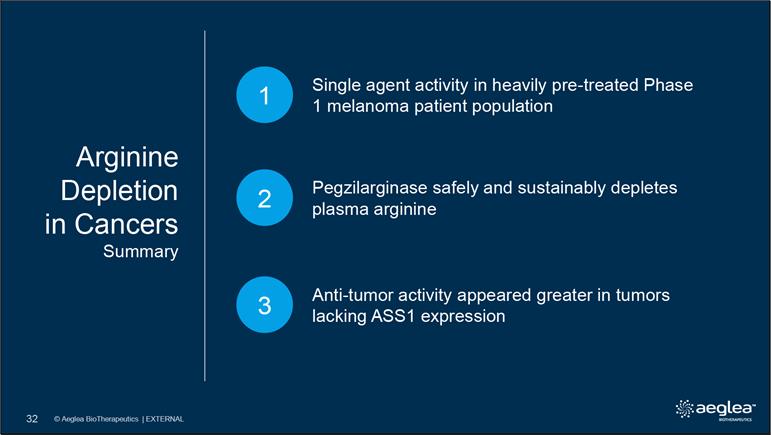
Arginine Depletion in Cancers Summary 1 Single agent activity in heavily pre-treated Phase 1 melanoma patient population 2 Pegzilarginase safely and sustainably depletes plasma arginine 3 Anti-tumor activity appeared greater in tumors lacking ASS1 expression 32 @ Aeglea Biotherapeutics I External Aeglea Biotherapeutics
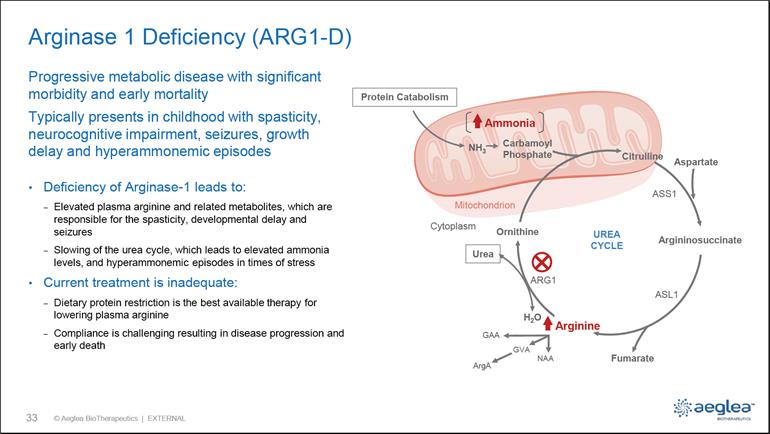
Arginase 1 Deficiency (ARG1-D) Progressive metabolic disease with significant morbidity and early mortality Typically presents in childhood with spasticity, neurocognitive impairment, seizures, growth delay and hyperammonemic episodes Deficiency of Arginase-1 leads to: Elevated plasma arginine and related metabolites, which are responsible for the spasticity, developmental delay and seizuresSlowing of the urea cycle, which leads to elevated ammonia levels, and hyperammonemic episodes in times of stressCurrent treatment is inadequate:Dietary protein restriction is the best available therapy for lowering plasma arginine Compliance is challenging resulting in disease progression and early death Protein Catabolism Ammonia Nh3 Carbamoyl PhosphateCitrulline Aspartatemitochondrion Cystoplasm Ornithine Urea Urea Cycle Argininosumccinate Arg1 H2o Arginine GAA GVA NAA ARGA Fumarate ASL1 33 @ Aeglea BioTherapeutics I External Aeglea Biotherapeutics

Designing Enzyme Therapeutics – Pegzilarginase pegzilarginase Substituted Metal Cofactor (Mn2+Replaced with Co2+) Catalytic activity serum stability 1000 800 600 400 200 0 40 30 20 10 0 kcat/km-1s-1 T1/2 (hr) Pegzilarginase pegylated native human arginase 1 pegzilarginase Pegylated native human arginase 1 4.8 +- 0.8 improved catalytic Activity & Serum Stability arginine (uM) Plasma Arginine levels in cynomologus monkey Pre-dose arginine plasma levels 100 10 1 0 lowest limit of detection time (hours) Pegylated native human arginase I (Single dose, 1 mg/kg ) Pegzilarginase ( single dose 1 mg/kg) Reduced circulating arginine levels 34 @ Aeglea BioTherapeutics Aeglea Biotherapeutics

Pegzilarginase: Clinical Benefit Associated With Extra-Hepatic Enhancement of Arginase 1 Enzyme Activity Clinical Description 5 y.o. male Spastic quadriplegia Hyperreflexia Mental retardation Loss of speech Unable to sit or crawl Red Blood Cell exchange improved clinical presentationi 700 600 500 400 300 200 100 580 76 high 176 462 55 Low 73 Before 506 46 191 After 367 108 90 Before 445 50 176 154 97 50Blood Exchange Proteine Diet Transfusion no change in condition slight improvement in spasticity Improved clinical Condintion Able to sit and roll over on his own Decreased spasticity Adapted from Sakiyama et al (1984) “A successful trial of enzyme replacement therapy in a case of Argininemia” J Exp Med. 35 @ Aeglia BioTherapeutics I External Aeglea Biotherapeutics



































